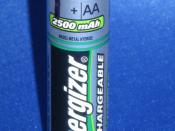Supply Chain Page � PAGE �4� of � NUMPAGES �4�
Week 2 - Achieving Competitive Advantage Paper
ISCOM 370 - Strategic Supply Chain Management
March 29, 2010
Achieving Competitive Advantage
The purpose of competitive advantage is to help an organization in the marketplace to stay one step ahead of the competition. Energizer Holdings and Duracell are organizations that have thrived on using competitive advantage through their supply chains. This paper will discuss the competitive advantages Duracell and Energizer Holdings have, how the supply chains gain the competitive advantages, and how ethical concerns, globalization, diversity, e-business, and innovation play a role in the organizations' supply chain.
Duracell is currently ranked as the number two ranked battery manufacture with a little more than 50% of the market share in alkaline batteries. Energizer Holdings is currently ranked at number three for the entire world. Duracell owns the Gillette Group, while Proctor & Gamble owns Duracell.
Energizer Holdings owns Schick Wilkinson Sword, Banana Boat, Hawaiian Tropic, and Playtex personal care and baby items. Having a large corporation like P&G owning Duracell helps their competitive advantage stay above Energizer because of the diverse products they offer in their product portfolio. Energizer Holdings had a great competitive advantage when they bought Schick Wilkinson Sword back in 2001. Adding the personal care to the Energizer product portfolio is what led P&G to follow by purchasing Duracell and Gillette.
Duracell's mission is the mission of P&G, which states:
We will provide branded products and services of superior quality and value that improve the lives of the world's consumers, now and for generations to come. As a result, consumers will reward us with leadership sales, profit and value creation, allowing our people, our shareholders and the communities in which we live and work to prosper (Proctor & Gamble, 2010).


